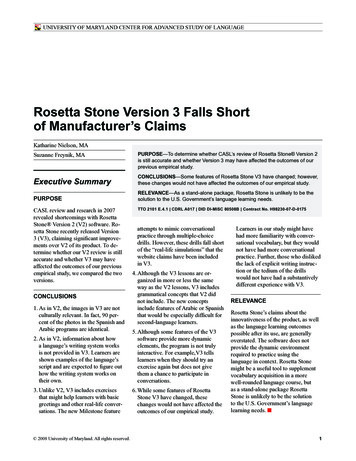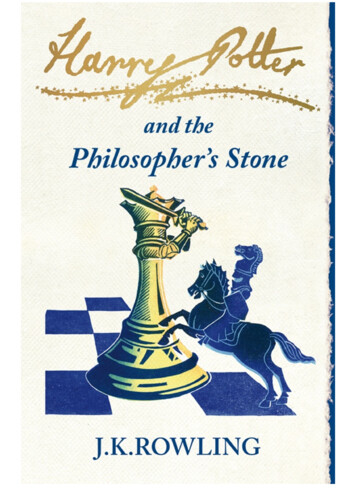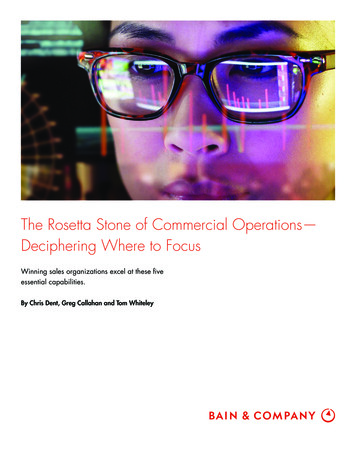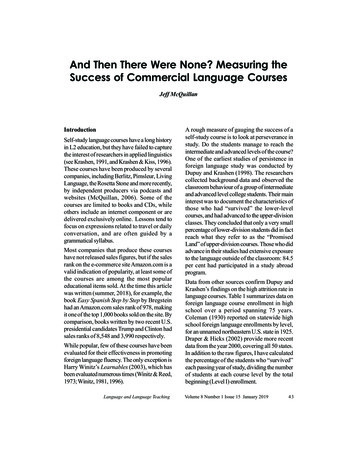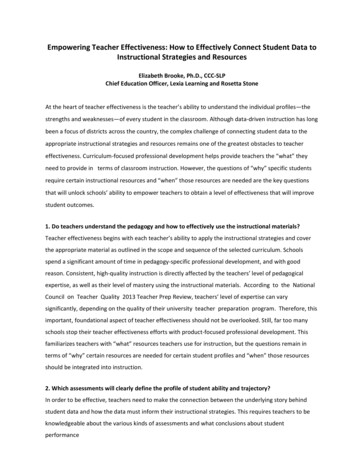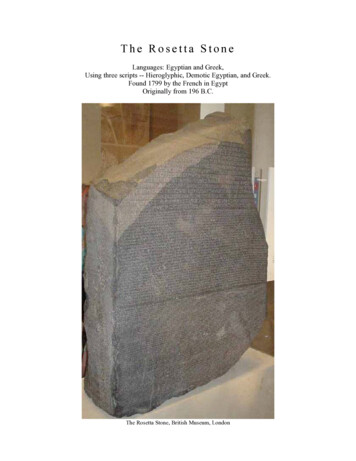
Transcription
The Rosetta StoneLanguages: Egyptian and Greek,Using three scripts -- Hieroglyphic, Demotic Egyptian, and Greek.Found 1799 by the French in EgyptOriginally from 196 B.C.The Rosetta Stone, British Museum, London
Hieroglyphic, [from theGreek priestly carving], type ofwriting used in ancient Egypt.Similar pictographic styles ofCrete, Asia Minor, and CentralAmerica and Mexico are alsocalled hieroglyphics.Interpretation of Egyptianhieroglyphics, begun by ThomasYoung and J. F. Champollionand others, is virtually complete.The meanings of hieroglyphicsoften seem arbitrary and areseldom obvious. Egyptianhieroglyphics were alreadyperfected in the first dynasty(3110-2884 B.C.), but theybegan to go out of use in theMiddle Kingdom and after 500 B.C. were virtually unused. There were basically 604 symbols thatmight be put to three types of uses (although few were used for all three purposes).1) They could be used as ideograms, as when a sign resembling a snake meant "snake." [Seechart above.]2) They could be used as a phonogram (or a phonetic letter similar to our alphabet), as whenthe pictogram of an owl represented the sign or letter “m,” because the word for owl had“m” as its principal consonant sound. [It would be like us using a picture of a snake for theletter “s.”]3) They could be used as a determinative, an unpronounced symbol placed after an ambiguoussign to indicate its classification (e.g., an eye to indicate that the preceding word has to dowith looking or seeing). The phonograms provided a basis for the development of thealphabet.Left - Demotic Egyptian detailDemotic refers to both theancient Egyptian script(derived from northernforms of hieratic used in theDelta) as well as the stage ofthe Egyptian languagefollowing Late Egyptian andpreceding Coptic. (There isalso a Demotic Greek, justto make things moreconfusing.) This languageand script were wellunderstood in the 19thcentury.
The Greek alphabet and language had never been forgotten andwas well understood in the 19th century. The general structureof ancient Greek is somewhat similar to English.
The English polymath Thomas Young(1773-1829) had been trying to decipherancient Egyptian hieroglyphs since theFrench army discovered the Rosetta Stonein 1799. He wrote this letter to the fatherof William John Bankes (1786-1855), theEnglish traveler and antiquary, in 1818.Bankes was traveling in Egypt at thattime and Young was hoping that hewould be 'able to assist in promoting theinvestigation of the hieroglyphicalantiquities of that singular country'.This is Thomas Young’s letter, from1818, describing his first hieroglyphicobservations. The following excerptsfrom this letter describe Young’srealization that the Rosetta Stone was akey to figuring out EgyptianHieroglyphics.
Here are some of his translations.He found the hieroglyphic symbols for Ptolemy’s name, but couldn’t figure out how to read itphonetically.Here is a detail from the stone itself Ptolemy’s name is shown here twice.
Ptolemy's name, which appears in the Rosetta Stone's Greek text as Ptolemaios, was the firstword recognized in hieroglyphics (see above). But early attempts to interpret its eight symbols werestymied by the traditional belief that all hieroglyphics could be translated as pictures of words.Even after Thomas Young assigned sound values to several symbols, Champollion held to the beliefthat the lion (one of the symbols in the word) symbolized the Greek word for war.Champollion eventually worked on the idea that Ptolemy might be read phonetically. Hereconstructed the name, sound by sound, from the Greek and Coptic into demotic, then into anearlier hieratic script and finally into hieroglyphics. The sound he arrived at was “p-t-o-l-m-y-s,” or“Ptolmis,” and could be spelled both right-to-left or in other directions. This discovery paved theway for deciphering the rest of the hieroglyphic text on the Rosetta Stone.In 1822, a copy of the inscription from an obelisk at Philae, excavated seven years earlier, wasmade available to Champollion. He was stunned to see confirmed in its hieroglyphics a name he hadreconstructed many times from a demotic papyrus: the cartouche of Cleopatra.
- Left - Autographed copy of the Lettre a M.Dacier, Paris, 1822The young French scholar Jean-FrancoisChampollion (1790-1832) made a crucialstep in understanding ancient Egyptianwriting when he pieced together thealphabet of hieroglyphs that was used towrite the names of non-Egyptian rulers.He announced his discovery, which hadbeen based on analysis of the RosettaStone and other texts, in a paper at theAcademie des Inscriptions et BellesLettres at Paris on Friday, 27 September,1822. The audience included his Englishrival Thomas Young (1773-1829), whowas also trying to decipher Egyptianhieroglyphs. Champollion inscribed thiscopy of the published paper withalphabetic hieroglyphs meaning 'mon amiDubois' ('to my friend Dubois').Champollion made a second crucialbreakthrough in 1824, realizing that thealphabetic signs were used not only forforeign names, but also for the Egyptianlanguage and names. Together with hisknowledge of the Coptic language, which derived from ancient Egyptian, this allowed him to beginreading hieroglyphic inscriptions fully.The picture to the left isPtolemy’s name extracted fromChampollion’s notes. On thefar left, running vertically isPTOLMEES in our Latinalphabet. Next to that is theGreek. In the next column isthe Demotic and in the lastcolumn are the EgyptianHieroglyphics. As you can see,one letter in our alphabet mayhave several equivalent symbolsin the Demotic script or theHieroglyphics.Hieroglyphics can be writtenin any number of directions, notjust left to right or right to left.
The following hieroglyphic has been reversed to accommodate Left-to-Right setta.htm
Forensic Tut ReconstructionNebkheperre Tutankhamun (alternate transcription Tutankhamen), named Tutankhaten earlyin his life, was Pharaoh of the Eighteenth dynasty of Egypt (ruled 1334 BC - 1325 BC), during theperiod of Egyptian history known as the New Kingdom.The 1922 discovery by Howard Carter of his nearly intact tomb received worldwide presscoverage and sparked a renewed public interest in Ancient Egypt, of which Tutankhamun remainsthe popular face.In 2005, three teams of scientists (Egyptian, French and American), in partnership with theNational Geographic Society, developed a new facial likeness of Tutankhamun. The Egyptian teamworked from 1,700 three-dimensional CT scans of the pharaoh's skull. The French and Americanteams worked plastic molds created from these -- but the Americans were never told whom theywere reconstructing. All three teams created silicon molds which are the most accurate replicationsof Tutankhamun's features since his royal artisans prepared the splendors of his tomb.
The English polymath Thomas Young (1773-1829) had been trying to decipher ancient Egyptian hieroglyphs since the French army discovered the Rosetta Stone in 1799. He wrote this letter to the father of William John Bankes (1786-1855), the English traveler and antiquary, in 1818. Bankes was tra


